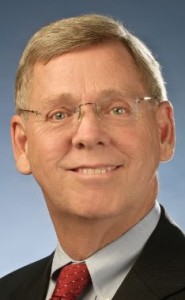
David Crowe
David Crowe is the Chief Economist and SVP with the National Association of Home Builders (NAHB). Dr. Crowe is responsible for NAHB’s forecasts of housing and economic trends, survey research and analysis of the home building industry and consumer preferences as well as microeconomic analysis of government policies that affect housing. Dr. Crowe is also responsible for the development and implementation of an innovative model which has estimated the net economic impact of new home construction in over 600 markets. Past research has concentrated on home ownership trends, tax issues, demographics, government mortgage insurance and local land-use ordinance impacts. Before becoming NAHB Chief Economist, Dr. Crowe was NAHB Senior Vice President for Regulatory and Housing Policy. Prior to NAHB, Dr. Crowe was Deputy Director of the Division of Housing and Demographic Analysis at HUD.
In January 2016, NAHB announced that Dr. Crowe will be retiring effective March 18, 2016, after 27 years as the association’s Chief Economist.
When you look back on your career, what are you most proud of having accomplished?
I continued to give the homebuilding industry the best possible information on the status of the housing market and the economy during the worst decline in housing since the Great Depression. NAHB as a whole, and I’ve been a part of that, has been diligent about providing accurate information even when it was information that the industry and individual builders didn’t want to hear.
Did they appreciate it even if it was information they didn’t want to hear?
Yes, they did. They were bright enough, smart enough, and pragmatic enough to understand they needed the bad news along with the slowly evolving good news.
What is your take on the housing inventory situation?
I don’t believe there is a shortage of new housing inventory. There is a shortage of existing housing on the market, and that’s the trickle effect. If there is a shortage of existing homes, that’s where brand new homebuyers come from—selling existing homes. If the existing homeowners are unwilling to sell for a variety of reasons, then they basically are not released to buy the new homes. The new home market is waiting on existing homeowners selling their current home to build more new homes.
It’s a domino effect—some existing homeowners can’t sell because they don’t have enough equity in their home to come out with a sufficient downpayment. Some of them no longer have the credit rating to get a mortgage. So there are some other reasons. But those that are just plain reluctant are often reluctant because they realize that if they want to buy an existing home, their options are relatively narrow. So it’s feeding on that reluctance that is continuing to keep the inventory low.
Many sellers may not have an absolute decision as to whether to buy an existing home or a new home. So the low inventory of existing homes is locking them in place, even though if they were to decide they wanted a new home, they probably would have a greater opportunity or greater selection from the inventory of new homes.
Is there a lack of demand for new homes?
There is a lack of demand for new homes for two reasons: Number one, very slim participation by first-time homebuyers. They don’t have to worry about selling a home, so they can move directly into a home without that concern about selling. But many first-time homebuyers are relatively young, so they suffer from the conditions that the millennials suffer from: Poor income growth, difficulty in getting a mortgage partly due to student debt and partly due to rigid standards, and their own preference for being footloose.
So number one, we don’t have a lot of buyers coming in from the first-time side because of those reasons. Number two, we have a reduced amount of buyers from existing homeowners becauser of this fear of rollover as well as similar financial issues such as insufficient credit or insufficient equity.
What in your opinion needs to happen in order for the housing market to be completely normal?
The rigid and inflexible mortgage underwriting standards that we’ve created need some flexibility. Policymakers went overboard in correcting the mistakes of the boom, and people are being excluded from mortgages that would make good credit risks. That’s number one.
Number two is the generally expanding economy. We’re getting that—it IS coming, but we have to continue to see the economy expand so people can feel secure in their jobs and therefore comfortable in making a major purchase like a house.
The third thing is on the supply side. We need more workers in the construction industry. Not having enough workers has slowed delivery. I think it’s still possible to build houses if there is a demand, but it takes longer to complete them.
After your retirement, how closely will you follow the housing market? Are you still going to keep up with it pretty regularly?
Yes. You can’t divorce yourself from it that quickly. It’s a habit, and I’ll keep it. It’s a fascinating industry, and I’ll continue to follow it.

 DSNews The homepage of the servicing industry
DSNews The homepage of the servicing industry










